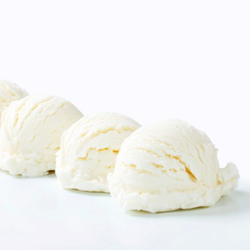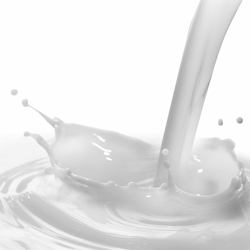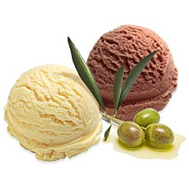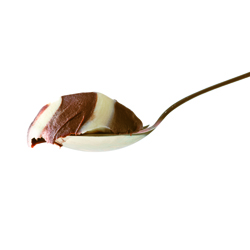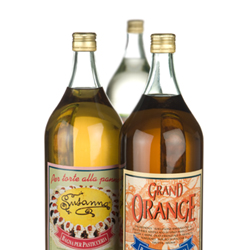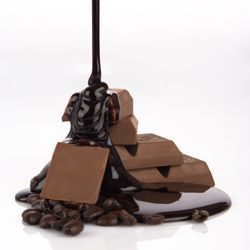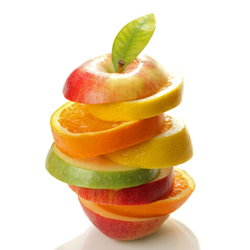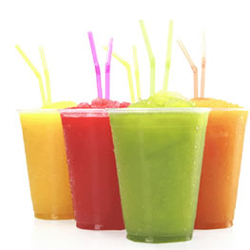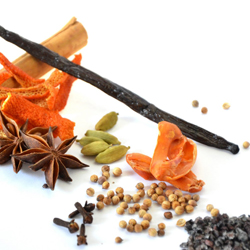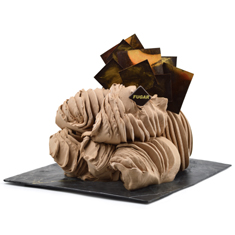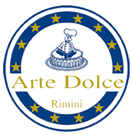
There are many theories about how traditional "gelato" (Italian ice-cream) originated: some owe more to fantasy than to fact, while others are backed up by recent archaeological evidence, showing how we discovered how to keep snow and ice cold as far back as the 18th century BC.
The history of ice cream melts into legend
There are a few things we do know: for example, in Florence, gelato was the brainchild of two fathers: Ruggeri and Buontalenti, who was also a talented chemist. In 1565, Buontalenti was responsible for organising a sumptuous banquet for a Spanish delegation visiting the Duke; one of the things he prepared for them was gelato. Thanks to his knowledge of chemistry, he prepared a mixture that is very similar to that used today to produce artificial ice.
The gelato he presented was very soft, but very well received.
The Spanish spread the news all over Europe and Queen Caterina De'Medici invited (or, according to some accounts, kidnapped) the Florentine gelato-makers.
Another version claims that ice-cream was first created, still in Florence, by a chicken-breeder named Ruggeri, who took part in a cooking competition with a frozen mixture of sabayon, cream and fruit.
He later moved to Paris, and rapidly became both rich and famous.
Modern history
The turning point for ice-cream making took place in 1927, when Otello Cattabriga from Bologna built the first automatic gelato machine. The result of eliminating the hard, manual labour involved in making gelato opened the way for women to work in the production laboratories.
The more recent history is better-known, and the developments of the last couple of decades have led us to where we are today, although at one point in the 1950s and 60s, traditional gelato nearly disappeared forever.
The onslaught of commercial ice-cream, with its new products and omnipresent advertising, often using stereotypes "borrowed" from traditional gelato, almost replaced the production of real traditional gelato.
Luckily, the work of a Committee of gelato-makers, set up thanks to the strong support of some of the more attentive operators in the sector to protect their profession, history and a unique and distinctive product, just as strong a symbol of Italian culture as pizza or spaghetti, led to a genuine renaissance in the sector: from only a few thousand, today there are around 25,000 gelato shops in Italy, a primate acknowledged the world over.

Like other food products, the quality entirely depends on the ingredients and therefore, the better the ingredients, the better the finished product.
Of course, to get a quality gelato, the ingredients must not only be top quality, but also correctly balanced. This is why it is so essential to balance the base mixture.

In traditional gelato laboratories, the components of the raw materials are divided according to the official classification of goods, into: water, sugars, fats, non-fat milk solids and other solids.
The first ratio to be set is between water and solids.
We have found that water can represent a minimum of 60% and a maximum of 68% of the mixture. The solids in the mixture can therefore account for between 32% and 40%.
Regarding the other components, sugars can take up between 16% and 22%, fats between 3% and 12%, non-fat milk solids between 5% and 12% and other solids between 1% and 5%.
Advantages and disadvantages of some gelato components
| Component | Advantages | Disadvantages |
| Sugars: | Make up the biggest source of solids: increase the body of the gelato | Lower the freezing point of the mixture. Lower the possibility of increasing the volume; sweetness is not always wanted. |
| Milk: | Liquid or powdered, it adds solids which are essential for the structure of the gelato. Adds fats, protein, vitamins, lactose; increases the volume of the mixture. | Can cause modifications in the structure of the gelato in storage; may be a source of bacteria if not properly pasteurised. |
| Fats | Add body; allow for a large increase in volume without affecting the structure; they make the structure softer. | In high quantities, they can lend the gelato an unpleasant flavour. In mixtures not adequately handled with the right machinery, they can cause separation. |
| Eggs: | Increase the nutritional value; they contribute to making the structure smooth; they make the gelato softer. | The typical egg flavour may be unpleasant; the egg whites can cause foam; cost. |
| Emulsifying agents: | Emulsify fat particles in the watery phase; improve the texture. | Can incorporate more air than the gelato can hold according to its composition. |
| Thickening agents: | Used to stabilise the mass, increasing its duration over time; make the structure smoother. | If used to excess, may cause the product to become too dense, making it difficult to whip; if too much, may cause the gelato structure to collapse. |
| Air: | An essential component of gelato; makes the structure soft; impossible to freeze, making the mass more resistant to changes in temperature. |

The first step of making gelato is pasteurisation, which involves transforming the raw materials and semi-finished products into a mixture, and above all using temperature to guarantee the necessary hygiene and health standards without altering the product's properties.
Pasteurisers are programmed to perform two different types of pasteurisation: low pasteurisation, which involves bringing the mixture to a temperature of 65° and keeping it there for 30 minutes, and high pasteurisation, which brings the mixture to 85° and keeping it there for 2-3 minutes.
In both cases, the mixture is then cooled to 4°C.
This heat treatment has very little impact on the mixture's organoleptic properties and allows the ingredients to amalgamate well, improving the quality of the product.
After pasteurisation, the mixture must be matured; this is essential in order to allow the solids in general and the protein in particular (from the milk and eggs) to become fully hydrated.
The pasteurised mixture can be used up to 72 hours after the cycle. After this period, the bacteria content would increase to the point that even an additional pasteurisation would not be able to make it usable.
Homogenisation
Alongside the pasteurisation phase, the homogenisation phase is also performed when the mixture is at a temperature of between 60 and
75 °C.
During this phase, the fats in the gelato are broken up and amalgamated.
The entire cycle takes a maximum of a couple of hours. The main aim of homogenisation when preparing traditional gelato is to create a uniform and stable suspension by reducing the size of the fat particles, which then form a smooth, creamy "layer".
The effects of homogenisation are important and have enormous advantages for traditional gelato-makers; let's take a look in more detail:
- exalting flavours: in fact, the organoleptic features of gelato are enhanced by the increased surface area that comes into contact with the taste buds;
- texture and body: the creamy surface that forms during the process perfectly integrates the various components of the mixture (fats, syrups, sugar solutions, emulsifiers, etc.), creating a much more stable, thicker gelato with a finer texture, thanks to the formation of smaller crystals.
Whipping and whipping machines
Whipping machines are a cylinder inside which the mixture is transformed into gelato as it changes state (from liquid to a creamy solid), as a result of three factors:
cold, stirring and the air.
Without the combined action of these three factors, gelato would be impossible to obtain.
The whipping machine removes heat from a certain part of the mixture, while stirring it well so that it draws in air and transforms into gelato. All this takes place in a short enough time to allow for several different flavours to be produced, to be placed in the display cabinets and/or storage.
Cooler
This is used to stabilise the temperature of just-whipped gelato in a couple of minutes, very rapidly crystallizing the water (25-30%) to ensure very small crystals, which are finer and last longer in the gelato produced.
Display cabinets
The displays do the important job of "keeping" a product which has finished changing state, but which can still undergo modifications due to the free water and sucrose in the recipe.
For gelato-makers, gelato should be easy to spread and divide, with an inviting texture, solid structure, without any sign of separation, loss of volume or formation of ice crystals.
Soft gelato machines
A Soft is essentially a type of whipping machine and storage unit in one, storing two different substances: the mixture and the gelato.
The gelato is stored at the right temperature and consistency in the whipping cylinder itself, allowing for a certain number of servings or cones according to the volume of the cylinder.

It is usually very easy to find nutritional information about commercial ice-cream (sold in cups, biscuits, cones or tubs), since nearly all modern packaging shows the calories per 100g and the macro-nutrients.
In contrast, it is much more difficult to estimate the calories in traditional gelato, where the amount of the highest-calorie ingredients (in particular sugar, and sometimes cocoa or fruit such as banana, avocado or dried fruit) varies according to the recipe used by each gelato-maker.
Traditional gelato
This type of gelato is characterised by the use of fresh raw materials. It is produced by slowly incorporating air to around 30-50% of the total volume, while freezing the mixture: the result is a soft and full-bodied cream.
The main differences from commercial ice-cream are as follows:
- lower fat content (5-8% in traditional gelato and 8-13% in commercial ice-cream);
- lower air content (max. 50% in traditional gelato and min. 90% in commercial ice-cream).
The main ingredient in traditional gelato (cream flavours) is milk (at least 70%), followed by sugar (18%) and cream (10%).
Usually, the base mixture for the different flavours is pasteurised in order to make it safe and hygienic.
Fruit flavours of traditional gelato, on the other hand, have more sugar as well as fruit (at least 25%).
Commercial ice-cream
This type of ice-cream is typically produced many months before it is used, using mixtures and raw materials such as powdered milk, concentrated fruit juice and additives such as colourings, emulsifiers, stabilisers and flavourings.
Commercial ice-cream is also known as streamed ice-cream, because the air is streamed into it during the freezing process up to 100-130%, making it very soft and light.
As it is distributed even in areas a long way from where it was produced, commercial ice-cream needs to be supported by an efficient cold chain, keeping it at a constant temperature always below -18°C all the way from production to the point of sale.
As we know, traditional gelato is formed by agglomerating air little by little into the base mixture made from fresh milk, sugar and other ingredients according to the flavour. Commercial ice-cream is often made with powdered milk, fruit juice instead of fresh fruit and other substances (as well as preservatives) such as colourings, additives to help the mixture emulsify, stabilisers and flavourings to make up for the lack of fruit or other base ingredients and make the product taste better.

Organoleptic quality
Sensorial analysis (using our senses) allowing for an integrated analysis of all the aspects that make up the quality of a product.
Microbiological and health quality
The producer is responsible for guaranteeing the hygiene and safety of products by making the right choices both in operating and management terms, in order to identify any consumer health hazards and the most appropriate controls and prevention measures.
Technological quality
The quality of the materials used; in order to be put on the market for sale, these must comply with standards which depend on the transformations that they go through (for example, milk must be pasteurised before sale).
Nutritional quality
The ability of a food product to provide nutrition. The food we eat provides our organism with substances known as nutrients, which are shown on nutrition information labels (protein, fat, carbohydrates or sugar).
Nutrition is the range of activities (metabolic phenomena) through which our body uses the main nutrients to meet its needs.
Transparency
Production transparency has become even more important since the introduction of Article 18 of the "Traceability" Regulation 178/2002 in 2005.
Nutritional quality, therefore, takes into account the raw materials used and the production process applied to obtain the gelato.
In fact, the nutrition content of the final product starts right from the raw material, and depends on the basic recipe; this recipe therefore needs to balance all the actual nutritional content, while also bearing in mind the production process.

